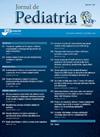Understanding the natural history of selective IgA deficiency
IF 2.8
4区 医学
Q1 PEDIATRICS
引用次数: 0
Abstract
Objective
Patients with selective IgA deficiency (SIgAD) present elevated morbidity associated with infections, allergic conditions, autoimmune disorders, and neoplasms. This study aims to characterize clinical manifestations, disease progression, and laboratory findings in a cohort of pediatric patients with SIgAD.
Methods
The study included patients with confirmed SIgAD and a clinical history of at least 5 years. Data encompassed clinical manifestations of the disease, patient outcomes, and laboratory findings, including IgA, IgG, IgM, IgE levels and complete blood count.
Results
A total of 51 patients (1.2:1 female-to-male ratio) were included, with a median age at diagnosis of 6 years. Infections were the most common clinical manifestations of SIgAD (98 %), with pneumonia being the most frequent (94 %), followed by sinusitis (70 %). Additionally, 47 patients (92.1 %) exhibited allergic manifestations, including rhinitis or asthma. Autoimmune conditions were identified in 10 patients, predominantly thyroiditis (60 %), while neoplasms were observed in 3 patients. The sequence of disease onset revealed a natural progression, beginning with infectious diseases, followed significantly by allergic and autoimmune conditions. Elevated immunoglobulin levels (IgM or IgG) were observed in 25 patients, with hypergammaglobulinemia significantly associated with autoimmune conditions or the presence of autoantibodies (p < 0.05).
Conclusions
SIgAD is a clinically significant condition. Understanding its natural history deepens our knowledge of the disease and helps early detection and diagnosis of comorbidities that may arise at various stages of a patient's life. Monitoring other immunoglobulin levels may offer potential biomarkers for predicting autoimmune conditions; however, larger studies are needed to validate these biomarkers.
了解选择性IgA缺乏症的自然历史。
目的:选择性IgA缺乏症(SIgAD)患者与感染、过敏性疾病、自身免疫性疾病和肿瘤相关的发病率升高。本研究旨在描述SIgAD患儿队列的临床表现、疾病进展和实验室结果。方法:研究纳入确诊SIgAD且临床病史至少5年的患者。数据包括疾病的临床表现、患者预后和实验室结果,包括IgA、IgG、IgM、IgE水平和全血细胞计数。结果:共纳入51例患者,男女比例为1.2:1,诊断时中位年龄为6岁。感染是SIgAD最常见的临床表现(98 %),肺炎最常见(94 %),其次是鼻窦炎(70 %)。此外,47例患者(92.1 %)出现过敏表现,包括鼻炎或哮喘。10例患者有自身免疫性疾病,主要是甲状腺炎(60% %),3例患者有肿瘤。疾病的发病顺序显示了一个自然的进展,从感染性疾病开始,其次是过敏和自身免疫性疾病。在25例患者中观察到免疫球蛋白水平(IgM或IgG)升高,高γ球蛋白血症与自身免疫性疾病或自身抗体的存在显著相关(p 结论:SIgAD是一种临床显著的疾病。了解其自然史加深了我们对疾病的认识,有助于早期发现和诊断可能出现在患者生命各个阶段的合并症。监测其他免疫球蛋白水平可能为预测自身免疫性疾病提供潜在的生物标志物;然而,需要更大规模的研究来验证这些生物标志物。
本文章由计算机程序翻译,如有差异,请以英文原文为准。
求助全文
约1分钟内获得全文
求助全文
来源期刊

Jornal de pediatria
医学-小儿科
CiteScore
5.60
自引率
3.00%
发文量
93
审稿时长
43 days
期刊介绍:
Jornal de Pediatria is a bimonthly publication of the Brazilian Society of Pediatrics (Sociedade Brasileira de Pediatria, SBP). It has been published without interruption since 1934. Jornal de Pediatria publishes original articles and review articles covering various areas in the field of pediatrics. By publishing relevant scientific contributions, Jornal de Pediatria aims at improving the standards of pediatrics and of the healthcare provided for children and adolescents in general, as well to foster debate about health.
 求助内容:
求助内容: 应助结果提醒方式:
应助结果提醒方式:


